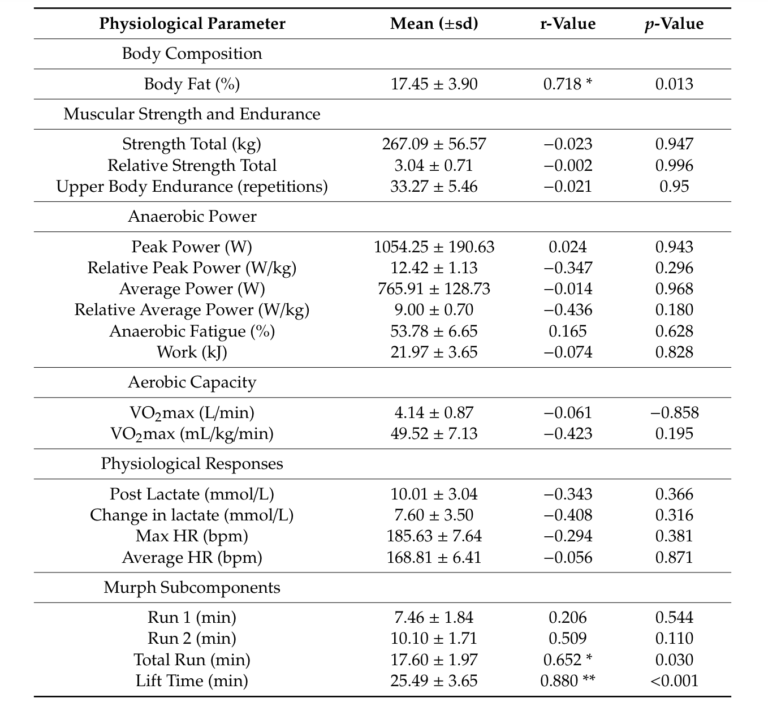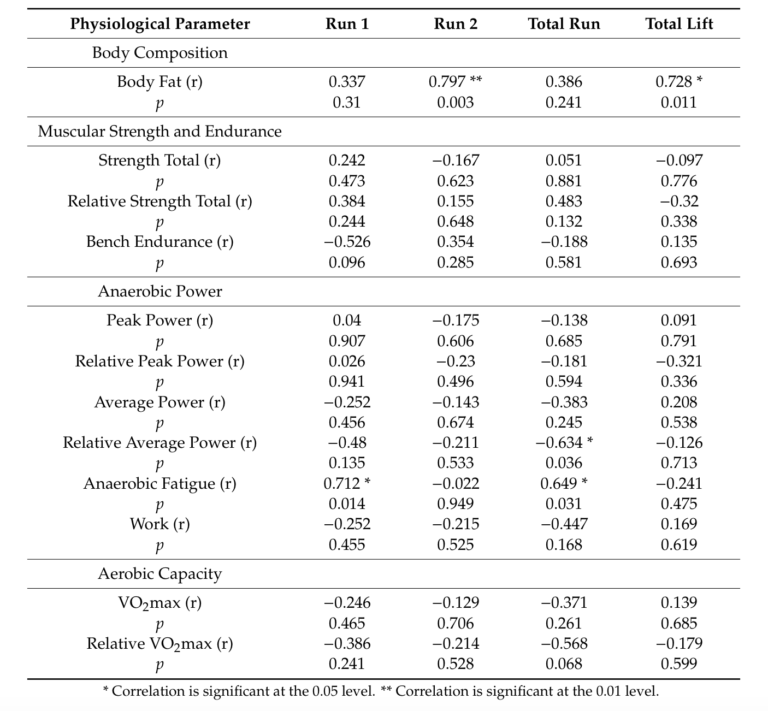This 2020 trial evaluated correlations between various physiological/performance measures and total time to complete Murph (1).
Researchers recruited 11 subjects from various CrossFit boxes. All had done CrossFit two or more times weekly for at least six months; mean CrossFit experience was four years. All subjects were male and between the ages of 21 and 31.
Subjects were weighed, and body composition was measured via DEXA. Performance benchmarks were then assessed as follows:
- Muscular strength: 1-rep-max bench press and back squat
- Muscular endurance: Number of bench presses completed at 50% of 1-rep max
- Anaerobic power: 30-second Wingate test
- Aerobic capacity: Treadmill test of V02 max
No fewer than 72 hours after these assessments were done, participants returned to the research site to perform Murph for time. Participants did not wear a weight vest.
Participant characteristics are summarized in the tables below.

Table assessing participant physiological parameters and physiological responses to Murph, respectively. R-values indicate correlation with overall Murph time, and p-values indicate the significance of these associations.

Correlations between physiological parameters and individual Murph components
Post-Murph lactate averaged 10.01 mmol/L. Max heart rate averaged 185.63 bpm, and mean heart rate averaged 168.81 bpm. Mean Murph completion time was 43.43 minutes, ranging from 36.56 to 54.21 minutes. Neither heart rate nor lactic acid levels correlated with total Murph time.
Lower body fat percentage significantly predicted lower total Murph time. On average, 58% of total time was spent on the push-ups, pull-ups, and squats; and 42% was spent on the two runs, with time to complete the middle section a stronger predictor of total Murph time than time to complete the run sections.
Interestingly, neither muscular strength nor muscular endurance predicted total time to complete Murph or time to complete the middle section. Similarly, VO2max did not predict either total Murph time or time to complete the running sections.
Researchers assessed tolerance of anaerobic fatigue as the rate of decrease in power during the 30-second Wingate test; higher performance in this measure correlated with significantly reduced time to complete the two runs. Increased anaerobic — not aerobic — power similarly correlated with a lower Murph run time.
Taken together, these results suggest body fat content and tolerance of anaerobic fatigue are the clearest determinants of Murph time within this small sample. Previous research across varied exercise disciplines has found a correlation between reduced body fat and increased performance (2). It is reasonable to expect this relationship to be even stronger within the context of Murph, given it consists entirely of body-weight exercises.
The researchers noted with surprise that VO2 max did not correlate with either overall Murph time or time to complete the run sections. Previous literature has shown, however, that measures of anaerobic fatigue, such as those tested here, correlate with performance in endurance-trained athletes (3). This suggests training programs that improve lactate tolerance may improve performance in high-intensity endurance tests like Murph; the high mean heart rate levels and high lactic acid levels reported suggest significant demand on anaerobic metabolism throughout the exercise period.
Overall, this study somewhat surprisingly found that neither muscular strength, muscular endurance, nor aerobic capacity correlated with Murph performance. Conversely, reduced body fat and increased tolerance of anaerobic fatigue predicted better times. These subjects were moderately trained. Therefore, these results may not predict results within either untrained or elite athletes. However, they may serve as a useful guide to the factors governing performance in many CrossFit athletes.

